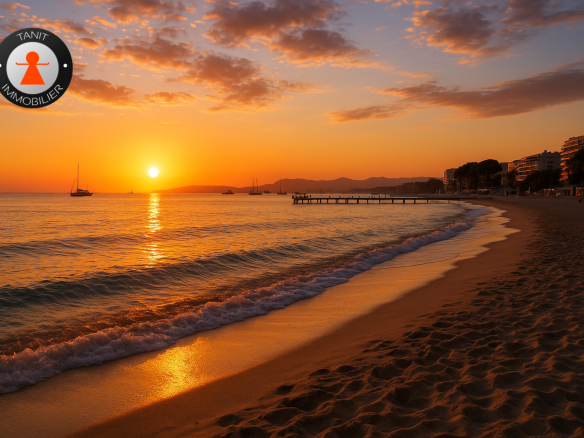Antibes, on the Côte d’Azur, is a popular place for families thanks to its many schools and modern facilities. Here’s a comprehensive guide for newcomers to better understand the educational opportunities and facilities available in this dynamic community.
Schools in Antibes
Antibes offers a wide range of educational establishments adapted to the needs of families. In 2023, the town will have 58 schools, including nursery, primary, secondary and high schools, both public and private.
1. Nursery schools
- 15 state schools: These establishments cater for children from infancy onwards and are spread across different parts of the town.
- 7 public schools: These include options such as Notre Dame de La Tramontane and Saint Philippe Neri, as well as international schools such as Littlephilo School.
2. Primary schools
- 14 state schools: These offer quality education that is accessible to all.
- 7 public schools: Some offer alternative teaching methods, such as the Montessori school in Antibes.
3. Colleges
- 5 state secondary schools: These are well equipped to support pupils throughout their education.
- 3 private colleges, including Collège Notre Dame de La Tramontane, renowned for its excellent academic results.
4. High schools
- 5 public secondary schools, including vocational establishments such as the Lycée Jacques Dolle.
- 2 private secondary schools, including the Lycée du Mont Saint-Jean, which has a baccalaureate pass rate of 100% in 2025.
How do Antibes schools manage sectorisation?
In Antibes, the management of school sectorisation is based on clear rules laid down by the municipal council, in accordance with the provisions of the Education Code. Here’s how it works:
1. Definition of school sectors
The town is divided into five geographical sectors for state nursery and elementary schools. Each sector corresponds to a specific group of schools, and children are assigned to a school according to their place of residence.
- Old Town Sector: Guynemer Elementary School, Paul Arène Preschool.
- Central Sector: J. Moulin, Tournière, Laval, Roger Cardi, and Super Antibes Schools.
- Southwest Sector: Saint Maymes, Pont Dulys, and Jacques Prévert School Groups.
- Eastern Sector: Fontonne, Jacques Boissier, and Saint Claude School Groups.
- Southern Sector: Ponteil School Group, Juan Gare Elementary School, Peynet Preschool, and Cap Primary School.
2. School enrolment
- Enrolments are managed by the Mairie on the basis of families’ home addresses and school capacity. Families must enrol their children in the school corresponding to their sector.
3. School exemptions
Although every child is enrolled in the school in his or her default sector, parents may request an exemption to enrol their child in another school. These requests are examined on the basis of specific criteria:
- Siblings already enrolled in the requested school.
- Medical or professional reasons.
- Schooling has begun at a specific school.
- Shared custody or moving during the year.
Exemptions are subject to availability and are not automatically granted. A committee examines these requests each year in May.
4. Role of local authorities
- The local council is responsible for delimiting school sectors for primary schools. For collèges and lycées, this responsibility falls to the departmental council and the regional council respectively.
5. Discussions on derogations
- The growing number of exemptions is sometimes the subject of debate within the town council. Some elected representatives are concerned about the imbalance that could affect the social mix and capacity management in certain schools.
To sum up, school sectorisation in Antibes is a structured system designed to ensure a balanced distribution of pupils, while offering a degree of flexibility through derogations.
Modern infrastructure
Antibes does not limit itself to its educational network. The town is also investing in modern infrastructure to improve its residents’ quality of life.
1. Public transport
The Envibus network efficiently connects Antibes to its surrounding area, particularly Sophia Antipolis. It offers several routes serving the town’s main districts and strategic points. The buses are equipped to meet the needs of families, with frequent stops and optimised journeys.
2. Urban development
The Combes district is an example of successful urban transformation:
- A new 70-bed crèche.
- A 1.5 hectare park with a green corridor.
- Cycle paths and an environmentally-friendly Bus-Tram system.
3. Green spaces
Antibes is focusing on sustainability, planting more than 500 trees and incorporating ecological innovations such as “rain trees” to manage rainwater. These initiatives aim to provide a pleasant environment for families.
What are the most recent infrastructures built in Antibes?
Antibes has undertaken a number of major projects to modernise its infrastructure and improve the quality of life of its residents. Here are the main recent achievements:
1. Jean Bunoz water sports stadium
- Type of project: Complete restructuring, including demolition and reconstruction of the main building.
- Features: A new 25-metre sports pool, a learning pool, a wellness area and 500 bleacher seats for competitions. A roof terrace with restaurant and fitness area is also planned.
- Budget: 29 million euros.
- Status: Scheduled for completion in 2026.
2. Port Vauban and Port Gallice
- Port Vauban: Creation of an “Artisan Village” dedicated to dry docking. Redevelopment of Anse Saint-Roch with a green public space, a pedestrian promenade, and a gateway building housing port services and a panoramic restaurant.
- Port Gallice: Renovation of the main jetty and the South building at a cost of €15 million over 15 years. Objective: To make Gallice a model in environmental management.
3. Autopont north of Antibes
- Description: A 100-metre aerial bridge linking the Hauts d’Antibes roundabout to the existing autopont towards Sophia Antipolis.
- Objective: Reduce traffic congestion at the Provence roundabout (estimated reduction of 20%).
- Budget: Not specified.
- Status: Scheduled for completion in September 2024.
4. Renovation of the Juan-les-Pins beaches
- Type of project: Transformation of the coastline with modernisation of seaside infrastructures, creation of belvederes and restoration of public spaces.
- Budget: €20 million.
- Impact: Boosting tourism and the economy while respecting the environment.
These projects reflect a strong desire to modernise Antibes and make it more attractive, while taking into account environmental and functional concerns.
Conclusion
Antibes is a destination of choice for families looking for a harmonious, secure and well-equipped living environment. With a wide range of schools, modern and accessible infrastructure, and a strong commitment to the inclusion and well-being of children, the town offers all the ideal conditions for families to settle in and develop over the long term. For new arrivals, Antibes is more than just a welcoming town: it’s a real place to live, conducive to education, leisure and family fulfilment.
➡ Tip: Thinking of moving to Antibes? Take the time to visit the different neighbourhoods with an eye on schools, infrastructure and transport. At Tanit Immobilier, we work with you to find the ideal property for your family, taking into account your educational priorities and lifestyle. Don’t hesitate to contact us for tailor-made assistance!




